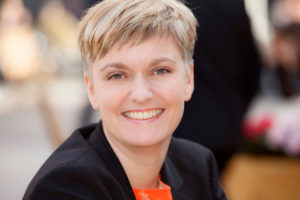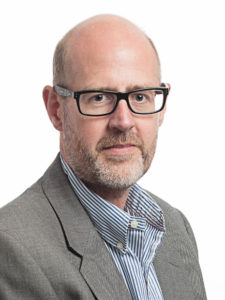Developing new standards is not always a swift process, and the 5G cellular data standard has been no exception. Almost as soon as LTE was upon us there was discussion as to whether or not it qualified as “true” 4G. Soon after the marketing departments spun-up promising us that as soon as we were enjoying 4G, 5G would come along and change everything — again.
In June this year, however, 3GPP, the international body that governs mobile telephony standards, announced that 5G was ready: a standard was born.
The 3GPP’s announcement of a finalised standalone standard for 5G communications followed an announcement in December 2017 of the completion of the 5G NR standard, designed for deployment on top of existing 4G LTE networks.

“In the port of Hamburg in Germany, they are looking at how they can use a 5G network to be a better port. They want to automate and optimise the way that they use the infrastructure in the port. That’s not consumer driven, but it’s [driving] a different [and new] kind of economics,” Jane Rygaard, Nokia
The news was not unexpected, of course; in February, a number of US cities — Atlanta, Dallas and Waco Texas, New York and Los Angeles — were announced as the first to get 5G service, and roll-out in Ireland will begin this year, with completion in 2019–2020.
But what will 5G offer? In technical terms, quite a lot. The IMT-2020 specifications demand a 20Gbps peak data rate and at least 100Mbps in real world conditions and latency of just on millisecond with a significantly greater connection density than existing cellular radio networks along with greater energy efficiency and spectrum-use efficiency.
In real terms, though, what it will deliver is two-fold. Firstly, ultra–high-speed broadband, and, if this works out, nothing short of an internet of things (IoT) revolution.
New communications
Equipment manufacturers have already deployed test networks based on the working standards of the last year, and are now working with telcos and other communication service providers to begin rollout.
Both Nokia and Ericsson spoke to TechPro to explain their vision of where things are going.
Jane Rygaard, heading of mobile networks marketing at Nokia, says things are becoming concrete very quickly.
“I would say that we’re engaging with over 50 customers worldwide. What is interesting is that the speed of change has increased. If you’d asked me last autumn, I’d have said: ‘Yes we’re looking at industries as a whole, with roll out in 2019, 2020’.
“If you’d asked me again in February of this year, I’d have said: ‘Rollout will be in 2018, with the first commercial launches in 2019.”
As a global standard, 5G is intended to be deployed worldwide, but the standard has been designed to be flexible to address different needs in different areas. In the United States, for instance, it will be used to deal with infrastructure problems not seen in Europe, primarily spectrum overcrowding and difficulty rolling-out fixed fibre.

“What is important is to provide that low latency, meaning 5G has to be provided in the core network, basically end-to-end. We talk about having compute capabilities close to the edge of the network, thus getting close to the user. It makes the networks intelligent, and also changes how they are built from an architecture point of view,” Hans Hammar, Ericsson
“It’s geographical and it’s current infrastructure and current spectrum. It will mean you don’t need to dig everything up to put fibre into every home.”
In Europe, she says, a lot of interest is around industrial applications due to what will be an explosion in available spectrum.
“We’re getting extra spectrum with 5G, opening up new ranges. We have more to use. In Europe at the moment there is discussion about 700 MHz, but what about 3.5 GHz or 28GHz? We suddenly have a lot of availability.
“In the port of Hamburg in Germany, they are looking at how they can use a 5G network to be a better port. They want to automate and optimise the way that they use the infrastructure in the port. That’s not consumer driven, but it’s [driving] a different [and new] kind of economics,” she said.
Ambition beyond
Hans Hammar, head of radio for Europe and Latin America at Ericsson, says that the mobile industry has an ambition to move into beyond mobile phones and traditional telco services.
“They want to address use cases like the vehicles, manufacturing and healthcare,” he said.
Initially, rollout, which he expects to begin by the end of this year, will be on top of existing LTE and 4G infrastructure.
“The high-band will be used first in the US. Here in Europe we will see the mid-band, which is closer to the traditional mobile networks so the coverage will not be significantly different.”
What will be different is the shape of the networks themselves.
“What is important is to provide that low latency, meaning 5G has to be provided in the core network, basically end-to-end. We talk about having compute capabilities close to the edge of the network, [thus] getting close to the user,” he said.
“It makes the networks intelligent, and also changes how they are built from an architecture point of view.”
Hammar says the nature of IoT applications themselves will be changed by the low latency and ability to connect more devices.
“Now what’s [going to be] available is what we call ‘massive IoT’; lots of different sensors and meters, producing small amounts of data more than just once or twice a day. What we’re looking at with 5G is lower latency and larger bandwidth for those devices. The third component there is ultra reliability, meaning you should be able to stay connected [at all times].”
Automotive automation is one obvious potential beneficiary of this kind of connectivity.

“Where 5G comes in, and this is why it threatens everyone, the technologies will deliver the bandwidth and the lack of latency, and, because of the density of the base stations, you’ll not get the current competition for data,” Paul Phelan, Data Edge
“If you have a remote-controlled car or a [factory] robot, then you need a very reliable and stable connections. It may not need extreme throughput, but strong throughput certainly,” he said.
One of Ericsson customers is wind turbine manufacturer that has used a 5G pilot scheme to add wireless sensors to its production line.
“That was not possible with any other radio technology,” he said. “Another example is a large manufacturing company in Italy that is developing production lines for the car industry. They see that 5G is the technology they need to give them flexibility in the factory. We’re removing all cables from the ship floor: adding a cable can be a large task, and moving machines can be an ordeal.”
Massive MIMO
Paul Phelan, chief technology officer at Data Edge, a Bray-based network management company says that central to 5G is ‘Massive MIMO’.
Massive MIMO, or massive multiple input multiple output, is intended to effectively double antenna capacity, and is an example of the requirement for complete rebuilding of the existing mobile networks.
“The early part of it is LTE Advanced, which brings in the minimum standard, but after that things change. Prior to 4G we didn’t use packet timed technology; we used a 2MHz sine wave. Then, with 4G, we had to introduce packet time technology, and now in 5G we have to look at timing on phase.
“The cells will be much smaller. In Greater London, for instance, they’re taking about 50,000 base stations, so think about every fifth lamppost being a cell,” he said.
LTE Advanced, or “4.5G” if you like, will be an intermediary step but, says Phelan, true 5G has the potential for major disruption, not just 4K streaming from Netflix.
“As we go from LTE Advanced to 5G the key things are, obviously, higher bandwidth, but also lower latency. The goal of 5G is [just] one millisecond. From a synchronisation perspective that means we have to time the network to the microsecond.
“Where 5G comes in, and this is why it threatens everyone, the technologies will deliver the bandwidth and the lack of latency, and, because of the density of the base stations, you’ll not get the current competition for data.

“NFV and SDN move telcos into the services world. That is a huge cultural and organisational shift for them, but if you do it and start to move things to the edge of your network you get the speed and latency benefits that 5G offers, and you’re in an environment where you can offer personalisation on a massive scale,” Nigel Stephenson, VMWare
“Think about the connected car,” he said. “it’s the most challenging [because] it’s [always] mission critical to have data connectivity and very low latency.”
There is more to 5G than just the hardware, though.
Software-defined
Nigel Stephenson, market development manager for EMEA region at VMWare’s telco network functions virtualisation group, says that software-defined networking is at the heart of the 5G proposition.
“It’s a new environment that we’re going into and the fundamental thing is programmable networks,” he said.
“NFV [network function virtualisation] and SDN [software-defined networking] move telcos into the services world. That is a huge cultural and organisational shift for them, but if you do it and start to move things to the edge of your network you get the speed and latency benefits that 5G offers, and you’re in an environment where you can offer personalisation on a massive scale.”
VMWare currently has over 50 communications service provider (CSP) customers and estimates that at least at least 300 million end-users are already using networks that take advantage of its virtualisation technologies.
Stephenson says that moving away from the traditionally siloed hardware-defined networks of the past will fundamentally change how telecoms companies offer their services, and that this is what will lead to new business applications in the field.
“There will be a new business model emerging, where they can capitalise on the fact that they have a very — physically — distributed network, which means it gets very close to the customer. If they can overlay that with cloud they can start providing very specific service capabilities. Others then can extrapolate and offer things in automotive, security, manufacturing, healthcare or whatever it is,” he said.
Irish industrial internet applications
Alan Davy, research manager at TSSG, the Waterford Institute of Technology’s Telecommunications Software and Systems Group said that among the industrial 5G applications that will drive adoption in Ireland is agriculture.
“Within Ireland in particular, agriculture is a very big industry,” he said.

5G will allow farmers to increase productivity and maintain an audit trail for animal welfare purposes, Dr Alan Davy, Telecommunications Software and Systems Group, WIT
Obviously farms worldwide have been home to several industrial revolutions of their own in the part hundred years, from mechanisation to veterinary medicine, the crop yield “green revolution” of the 1960s and, perhaps controversially, biotechnology and genetic modification. Ireland is no exception to this rapid pace of change, but says Davy, 5G’s role in farming will be in line with Ireland’s positioning of itself as a major producer of grass-fed dairy and beef.
“With dairy we’re on par with a global leaders, and we [at TSSG] have a number of projects going on with Dairygold, Glanbia and so on, looking at how we can push 5G into the dairy sector,” he said.
5G will allow farmers to increase productivity and maintain an audit trail for animal welfare purposes.
“We’ve a project here with a local farmer, deploying sensors on the cow’s front leg, looking at their activity patterns, showing signs of lameness earlier than the farmer would traditionally find out, and so on. The end goal is to increase the productivity: he gets an app notification and go and have a look [and] he can also show that he has good welfare practices on his farm,” said Davy.
TSSG which includes 100 master’s and PhD students, plus postdocs and team of software engineers, also works as part of Science Foundation Ireland’s “Connect” project looking at the future of networks alongside industry partners including Intel, Google, Huawei, Nokia, IBM, ESB, Rivada Networks and Dublin City Council.
TSSG is also working with Dell EMC and others in what it describes as a “ground-breaking” €3.5 million EU-funded “Beyond 5G” project, but, obviously, in order for 5G to make inroads in Ireland the telecoms networks have to deploy it first.
Trialled options
Max Gasparroni, head of networks at Vodafone Ireland says that Vodafone is ready to do so, having trialled it in December 2017.
The first thing it will bring is faster mobile broadband, but this is not the end goal, he says.
In fact, in Vodafone’s view the use cases will follow the deployment of the technology.

“For us 5g is not just faster infrastructure; it actually enables — will unlock — a huge number of use cases as there are four features to it. Firstly, ultra–high-speeds, then the ability to connect a massive amount of devices, thirdly reliability and, finally ultra-low latency. All these are brought in by an architectural revolution,” Max Gasparroni, Vodafone Ireland
“For us 5G is not just faster infrastructure; it actually enables — will unlock — a huge number of use cases as there are four features to it. Firstly, ultra–high-speeds, then the ability to connect a massive amount of devices, thirdly reliability and, finally ultra-low latency. All these are brought in by an architectural revolution,” he said.
The sheer amount of data and connections that 5G is designed to handle is what needs to be grasped, he says.
“This means the internet of things revolution which we are already working with in 4G. Well, 5G will take this into a new dimension. You’ll be able to see an exponential growth of objects connected to the internet, such as smart hime, smart cities in general, smart travel infrastructure and so on. These sensors don’t necessarily send a huge amount of information, but they transmit frequently—and there’s a lot of them,” he said.
One of Vodafone’s recent trials demonstrated 5G’s ability to go where no low powered radio signal has gone before: deep underground.
“It means there has to be support for deep indoor penetration. It can penetrate through two extra set of walls. We trailed this with a water company who had a pumping station fifteen metres below ground. They were adamant that there was never coverage — and would never be. But with narrowband we were able to get a signal down there,” said Gasparroni.
Vodafone announced in February that it expects its network rollout in the Irish market to happen within the next twenty to 24 months, and Gasparroni says the company is on-track.
What is needed now, though, is devices.
“It’s a question also of availability for the customers. We need devices that are 5G capable,” he said.
Speculative
VMWare’s Nigel Stephenson says that there is a lot riding on 5G but that the business case remains speculative for now.
“I just came from an event looking at the business case for 5G and, to be honest, it’s not immediately apparent. There is, however, an inevitability to it. The carriers we spoke to are all going there,” he said.
According to Stephenson, where 5G will work best is in improving things that can already be done.
“I see it as an enabler rather than an opportunity. The real opportunity is in the internet of things and mobile edge computing. These can stand on their own, but have a lot more to offer if they are combined with 5G,” he said.
In the meantime, it is consumer technology that will have to do the heavy lifting, pushing the market penetration that makes the network rollout viable.
As Nokia’s Rygaard said; “There is no doubt that the standards are addressing more broadband: extreme broadband. The next ones are looking at ultra-reliability and ultra-low latency, which is more industrial [but] we [will] see more and more of this on top of the faster broadband and discussion about streaming.”








Subscribers 0
Fans 0
Followers 0
Followers